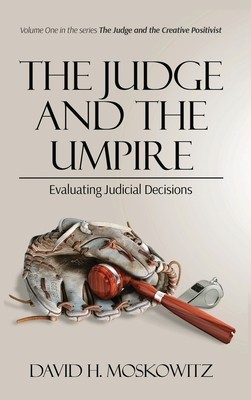
- We will send in 10–14 business days.
- Author: David H Moskowitz
- Publisher: Huge Jam
- ISBN-10: 1739182936
- ISBN-13: 9781739182939
- Format: 15.2 x 22.9 x 2.1 cm, hardcover
- Language: English
- SAVE -10% with code: EXTRA
Reviews
Description
This book is the first of four volumes published under the series title The Judge and the Creative Positivist. Creative positivism is a legal philosophy that is an extension of H.L.A. Hart's legal positivist theory presented in his classic work The Concept of Law. Moskowitz identifies 'hard' cases that do not fit easily into Hart's rule of recognition; cases in which there are gaps, open texture or penumbral factual situations. He then modifies Hart's version of the discretionary theory that limits the exercise of discretion in making judicial decisions. The author is in a unique position to do so thanks to his having studied under Hart at Oxford, providing the latter at his request with a critique of the The Concept of Law while it was still in draft form. He demonstrates through the creative positivist theory how discretion is exercised in 'easy' cases too, where the law is determinate. In so doing, Moskowitz adds to Hart's primary and secondary rules a new set of tertiary rules.
The Judge and the Umpire springs from a reaction against a supreme court judge's direct attempt to assimilate the two roles in his inaugural speech. In short, the author argues, because judges are authorized to create new legal rules, they are not like umpires who call balls and strikes with no authority to change the rules.
This series will be invaluable to students of US jurisprudence and legal philosophy and provide researchers with a ground shifting new theory. This first volume examines six cases in detail, providing an introduction that is accessible to undergraduates and to general readers with an interest in the context of existing judicial decisions.
www.thecreativepositivist.com
Published by www.hugejam.com, 2022
EXTRA 10 % discount with code: EXTRA
The promotion ends in 20d.02:16:23
The discount code is valid when purchasing from 10 €. Discounts do not stack.
- Author: David H Moskowitz
- Publisher: Huge Jam
- ISBN-10: 1739182936
- ISBN-13: 9781739182939
- Format: 15.2 x 22.9 x 2.1 cm, hardcover
- Language: English English
This book is the first of four volumes published under the series title The Judge and the Creative Positivist. Creative positivism is a legal philosophy that is an extension of H.L.A. Hart's legal positivist theory presented in his classic work The Concept of Law. Moskowitz identifies 'hard' cases that do not fit easily into Hart's rule of recognition; cases in which there are gaps, open texture or penumbral factual situations. He then modifies Hart's version of the discretionary theory that limits the exercise of discretion in making judicial decisions. The author is in a unique position to do so thanks to his having studied under Hart at Oxford, providing the latter at his request with a critique of the The Concept of Law while it was still in draft form. He demonstrates through the creative positivist theory how discretion is exercised in 'easy' cases too, where the law is determinate. In so doing, Moskowitz adds to Hart's primary and secondary rules a new set of tertiary rules.
The Judge and the Umpire springs from a reaction against a supreme court judge's direct attempt to assimilate the two roles in his inaugural speech. In short, the author argues, because judges are authorized to create new legal rules, they are not like umpires who call balls and strikes with no authority to change the rules.
This series will be invaluable to students of US jurisprudence and legal philosophy and provide researchers with a ground shifting new theory. This first volume examines six cases in detail, providing an introduction that is accessible to undergraduates and to general readers with an interest in the context of existing judicial decisions.
www.thecreativepositivist.com
Published by www.hugejam.com, 2022


Reviews